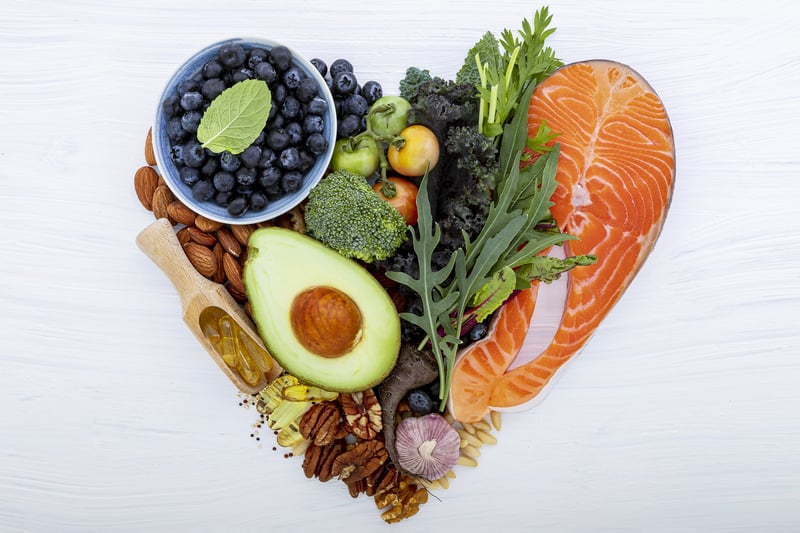10 Heart-Healthy Foods to Work into Your Diet

At the heart of your health is… well, your heart. No matter how young or old you are, taking care of this vital organ is essential. While it’s true that the younger you are when you start, the better, it’s also true that it’s never too late to make heart health a priority—even if you’ve already suffered a setback. Of course, choosing heart-healthy foods is one of the best ways to help keep your ticker in tune or help it recover if it has lost some of its rhythm.
Reasons to Keep the Heart Healthy
Heart disease is responsible for nearly a third of all deaths worldwide, and it’s the number one cause of death every year in the United States, claiming, for instance, 659,041 lives in 2019.1
In addition to being one of the keys to overall health, embracing a heart-healthy diet and lifestyle can also decrease the risk for:
- High blood pressure
- High cholesterol
- Heart attack
- Stroke
- Type 2 diabetes
- Asthma
- Joint pain
- Cancer
What’s more, a heart-healthy lifestyle that incorporates regular exercise can boost mood and energy levels, as well as help alleviate chronic stress.
You can also lower the risk for heart disease and related issues by ensuring you don’t smoke, keeping blood pressure and cholesterol levels in check, and watching your weight. Even if your family has a history of heart disease or you’ve already stumbled on taking care of your heart, you can improve your odds, starting in the grocery store.
10 Heart-Healthy Foods
What heart-healthy foods should you pile on your plate? I’m glad you asked.
1) Leafy greens, like kale, spinach, and romaine lettuce, are a great place to start as they provide an abundance of vitamins, minerals, and antioxidants. This includes vitamin K, which is vital for protecting the arteries, 2 as well as nitrates, which support blood vessel health. 3 Don’t forget other cruciferous vegetables either. Broccoli, cauliflower, and Brussels sprouts are also heart-healthy foods.
2) Pump up the flavor and nutrition of your recipes by tossing in some garlic. Garlic (as well as onions) provides the compound allicin, which may have several health-enhancing effects, including helping reduce blood pressure and total and LDL cholesterol. 4 It may also help reduce the buildup of platelets, which can help reduce the risk of blood clots and strokes. 5,6 To encourage allicin formation, dice or crush your garlic, then allow it to sit for a minute or two before adding it to your recipe.
3) Avocados are rich in healthy fats (e.g., the monounsaturated fatty acid oleic acid) that have been linked to decreased cholesterol, especially the more dangerous small, dense LDL, to help protect heart health. 7 Eating avocadoes regularly has also been shown to reduce the risk of metabolic syndrome by as much as 50%. 8 So, when they’re in season and available, go ahead and indulge.
4) Foods high in lycopene—such as tomatoes and watermelon—are superstars when it comes to supporting the body’s antioxidant pathways and capacity to neutralize free radicals, which is important for preventing excessive oxidative stress and inflammation. Indeed, when lycopene levels are low, the risk of heart attack and stroke may be increased. 9 – 11
5) You can then treat yourself with bright, colorful fruits like blueberries, raspberries, and blackberries. Berries are rich in heart-healthy compounds, such as polyphenols (e.g., anthocyanins). 12 The consumption of a variety of berries has been found to help lower LDL cholesterol, systolic blood pressure, body mass index, and some inflammation markers. 13
6) While you’re enjoying your berries, add some walnuts, almonds, or other nuts or seeds for flavor and crunch. You’ll be rewarding your body with heart-healthy fats, fibers, phytonutrients, and micronutrients like magnesium, copper, and manganese. Adding a few servings per week can decrease LDL cholesterol, lower blood pressure, and promote healthy levels of oxidation and inflammation, which can also help reduce the risk for heart disease. 14, 15
7) You don’t need to avoid other carbs either. Whole grains, such as quinoa, brown rice, oats, and whole wheat, provide a wealth of fiber, which can help reduce LDL cholesterol, decreasing the overall risk of heart disease. 16
8) Another heart-healthy food that should be on nearly every healthy grocery list is beans. Because they provide (particularly when they’re cooked then cooled) resistant starch, a special type of carbohydrate that resists digestion and thus feeds the beneficial bacteria in the gut, beans and legumes may help decrease triglycerides and cholesterol and thus reduce the risk for cardiometabolic issues. 17 – 19
9) Another often-demonized food that’s good for heart health is the humble spud; yes, that’s right, I said potatoes. While you’ll want to avoid them when they’re in their “chip” or French fried forms, potatoes are a rich source of nutrients, including potassium and fiber. 20 Because potatoes are so satiating, they may also help support weight management as they can help you feel satisfied and stay full for longer. Finally, when cooked and then cooled, potatoes are a tasty source of resistant starch.
10) If fatty fish isn’t already on your grocery list regularly, now’s the time to get it on there. Fish like salmon, mackerel, sardines, and tuna are rich in protein as well as omega-3 fatty acids. The regular consumption of fish (one to three times per week) has been shown to lower diastolic and systolic blood pressure. 21 It’s also been shown to decrease levels of cholesterol, triglycerides, and blood sugar.
Keeping the heart in tune requires a variety of healthy vegetables, fruits, whole grains, nuts, seeds, and legumes. But it doesn’t stop there. You can help your heart stay in shape by watching your weight, staying active with regular exercise, routinely getting your blood pressure checked, avoiding smoking, and making oral health a priority.







